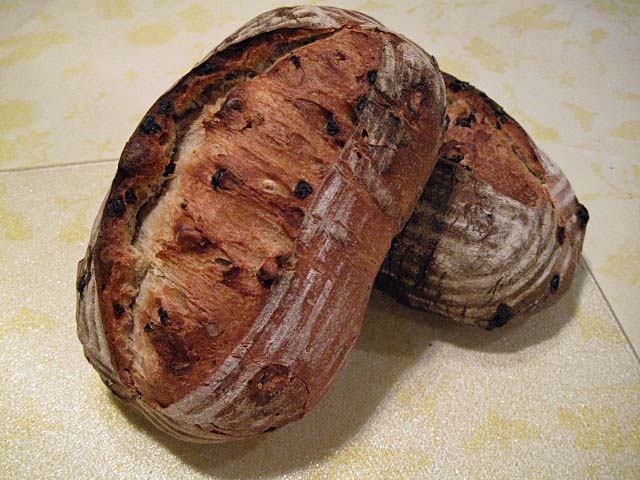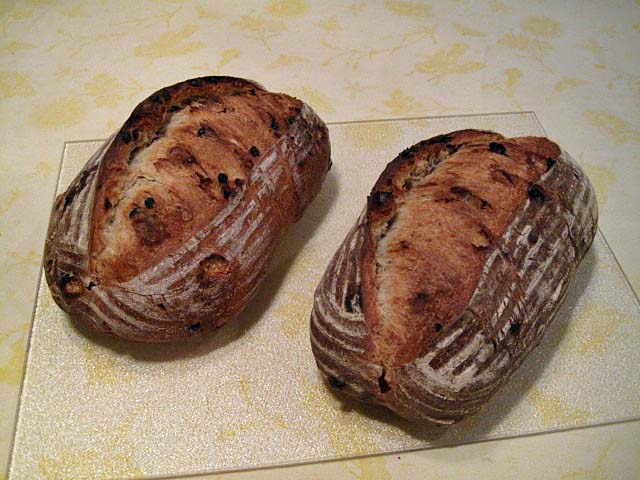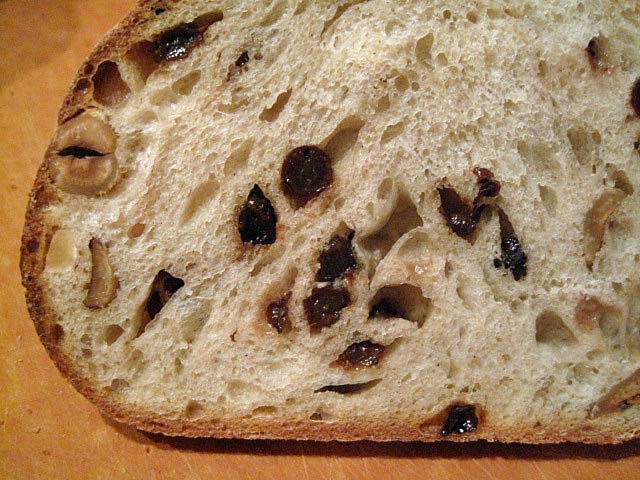
I've been thinking about baking a sourdough nut bread for some weeks. They are so nice plain and with cheese. With lots of family expected for several days around Thanksgiving, I'll want a variety of breads I can take out of the freezer to serve with meals and for snacks. I like to serve sourdough nut breads with hors d'oeuvres.
I thought over the breads with nuts I've made before but decided to try something new: a French-style (not too sour) Pain au Levain with hazelnuts and currants.
I based the bread on Hamelman's Pain au Levain from “Bread.” I added about 25% nuts and currants to the dough at the end of mixing and followed Hamelman's procedure for bulk fermentation, proofing and baking.
|
Levain build |
Wt. |
Baker's % |
|
KAF AP flour |
4.6 oz |
93.50% |
|
Medium rye flour |
0.3 oz |
6.50% |
|
Water |
3 oz |
60.00% |
|
Mature (stiff) starter |
1 oz |
20.00% |
|
Total |
8.9 oz |
|
|
Final dough |
Wt. |
|
KAF AP flour |
1 lb, 9.8 oz |
|
Medium rye flour |
1.3 oz |
|
Water |
1 lb, 1.8 oz |
|
Salt |
0.6 oz |
|
Levain |
7.9 oz |
|
Roasted hazelnuts |
4 oz |
|
Zante currants |
4 oz |
|
Total |
3 lb, 13.4 oz |
Procedure
-
Mix the final levain build 12 hours before the final mix. Cover the bowl and let it ferment at room temperature (about 70ºF).
-
Mix all the ingredients except the salt and levain to a shaggy mass. Cover and let rest (autolyse) for 20-60 minutes.
-
Sprinkle the salt over the dough and distribute chunks of the levain over the dough. If using a stand mixer, mix with the paddle at Speed 1 for 1-2 minutes to incorporate the added ingredients and then with the dough hook for about 6 minutes at Speed 2. There should be moderate gluten development. Add the hazelnuts and currants and mix for another 2 minutes or so at low speed. Desired dough temperature is 76ºF.
-
Transfer the dough to a lightly floured board and knead briefly to evenly distribute the nuts and currants. Then round it up and place it in a lightly oiled bowl and cover tightly.
-
Bulk ferment for 2 ½ hours with two folds at 50 minute intervals.
-
Divide the dough into two equal pieces and preshape as rounds or logs. Let the pieces rest for 20 minutes.
-
Shape each piece as a boule or bâtard and place en couche or in a banneton. Cover with plastic or a towel.
-
Proof the loaves for 2 to 2 ½ hours.
-
Preheat the oven to 500ºF with a baking stone and steaming apparatus in place 45 to 60 minutes before baking.
-
When proofed, transfer the loaves to a peel, score them and transfer them to the baking stone.
-
Turn the oven down to 440ºF and bake with steam for 15 minutes, then in a dry oven for another 25-30 minutes.
-
Transfer the loaves to a cooling rack, and cool completely before slicing.
-
To steam the oven, I use a cast iron skillet filled with lava rocks. This is pre-heated along with the baking stone. Right after the loaves are loaded on the stone, I place a perforated pie pan with 10-12 ice cubes on top of the lava rocks.
-
I start my bake with the oven at conventional setting. At the end of the steaming period, I switch the oven to convection bake and lower the temperature 25ºF.
-
For this bake, when the loaves were fully baked, I turned off the oven and left the loaves on the stone with the oven door ajar for 10 minutes.
Notes on my baking procedure


We tasted the bread when (almost completely) cooled. The crust is very crunchy. The crumb was denser than I had hoped, although this is a rather low-hydration bread. My experience with nutted breads has always been that the crumb tends to be less open than expected, so now I expect it.
The crumb was very chewy. The flavor of the bread was lovely, with no perceptible sourness, except for the sweet-sour flavor of the currents. At this point, the bread, nuts and currents each contributes its distinctive flavor. Quite nice.
I'm looking forward to having this bread toasted for breakfast.
David
Submitted to YeastSpotting
- dmsnyder's Blog
- Log in or register to post comments
David these look absolutely wonderful! I can't wait to see the crumb but from a distance it looks promising.
Could you share your freezing and warming procedure with us? Getting these ready early would be a great idea.
Eric
I freeze loaves by wrapping them in two layers of Freeze-tite(tm) plastic wrap and then placing them in a food grade plastic bag, tied shut.
Sometimes I thaw loaves with a few seconds in the microwave, then a few minutes in a hot oven. However, most of my breads seem best when thawed at room temperature, unwrapped. Remember though, I live in a pretty dry climate.
David
David, Fruit and nut loaves are so great this time of year and yours looks beautiful, all around and delicious! The crumb looks wonderful and I like it without the big holes. I have been planning on using a nice country loaf for my nuts and fruit loaves this year.
I have heard that removing your loaf before thawed from it's bag, makes the loaf dryout...it's been a long time since I've tried it any other way. What advantage do you get by remove your loaves from the wrapping befor thawing, rather than leaving them in the bag to thaw?
For a crispy crust and warmed before eating, I wrap it in foil and then heat it in moderately hot oven for a few minutes...I've found this to be good if the loaf is eaten right away, but later tends to also dry the bread and it works on stale bread for a one time freshen up. Also works fantastic for reheating pizza to a crispy crust...this hint given to me by a pizziola guy, to make it closest to when it came out of the oven...I've also tried it with left over prepared pizzas and then frozen, not bad at all...just be sure and don't let the foil touch the cheese.
Sylvia
i gave an abbreviated response to Eric's question.
When thawing a high-hydration, large loaf, thawing un-bagged dries the crust (which is a good thing) but leaves the crumb more moist than thawing with oven heat.
When thawing a baguette, your method works better.
I often will take out a frozen half loaf of a bâtard or boule when I'm cooking dinner. I unwrap it, and place it cut side down on a board. When I'm ready to slice it, it may still be part-frozen, but it can be sliced. The slices thaw in 3-5 minutes. This works for me.
David
Yummy looking loaves, David, the hazelnuts and currants are just oozing out. I haven't made the fruit loaves for quite a few weeks now. SD fruit loaves bake next weekend for me, I say.
Sue
http://youcandoitathome.blogspot.com/
Hello, Your sourdough nut loaves look very, very nice!
I tried an Apple, Cranberry and Hazelnut Sourdough recently and in reviewing the formula I used, inclusions are about 50%. I struggled a bit trying to get everything to incorporate into the dough! When I make this one again, I'll reduce inclusions to 25% as you have done. Your crumb shot shows a nice distribution of currants and hazelnuts...enjoy your toast! Regards, breadsong
Hi David,
Nice soft crumb you have, and no fat in the formula, either: excellent result!
Have you made Hamelman's Hazelnut and Prune bread? It's similar to this, but has a little butter in and the flour mix uses wholemeal more generously, and no rye. I loved that, and, yes, they freeze so well. See: http://www.thefreshloaf.com/node/18164/whitsuntide-baking-and-other-antics
Best wishes
Andy
I did look at the Hazelnut and Prune Bread, but I wanted a lean bread for this bake. In hindsight, I might like the effect of the butter and whole wheat better. I'll have to give it a go.
The crumb in the bread I made was surprisingly chewy - not really soft. I may have over-developed the dough. I also didn't rinse the currents, and they absorbed quite a bit of water, resulting in a dough that was effectively lower hydration.
One learns from every bake, eh?
David
Great looking loaves!
Looks likes your standard exceptional bake David, with a perfect crust and crumb.
This is such a good bread for toast, I know you'll enjoy it. I made this one a few months back and I think it was eaten almost exclusively as toast ,except for a roasted chicken sandwich...or two.
Franko
I love the choice of hazelnuts and currants; they aren't likely to overwhelm the delicate flavor of the bread, but what a great addition when accompanied with a good cheese or spread.
Thanks for the creativity and sharing with us.
Larry
What a gorgeous bread!
I had the same idea, fed my starter this morning, and my hazelnuts, raisins and stuff are soaking as we speak. The dough will be retarded overnight. If my bread comes out half as lovely as yours I'll be happy!
The bread was good toasted. However, I learned yet again I prefer a more sour sourdough.
David
David--
It's like a Cheshire Loaf. All you can see is the grin.
Your baking is something else for which to give thanks. I bet your sister-in-law would love that bread with Cotswold cheese.
Glenn
Hello, David
I like to take a bench time before shaping or after bulk fermentation. I think that is easier to make the dough into any shapes.I use to do that to make commercial bread, and I like Hamelman's Pain au levain, too. I want to use your recipe when I make it with nuts that would be a nice treat for our family!
Thank you for sharing with your recipe!! They look so tasty!
Akiko
They look beautiful! This is my all time favorite "Bread" recipe.
Pam